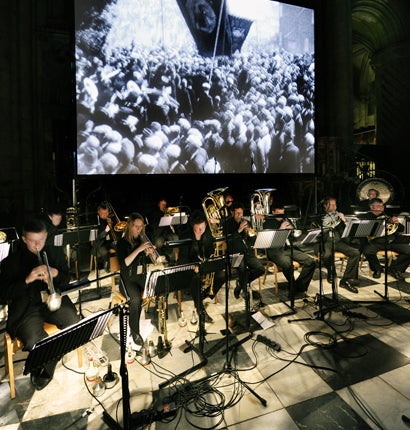The Miners' Hymns, The Cathedral, Durham
An ambitious amalgum of music, film and, er, coal

Your support helps us to tell the story
From reproductive rights to climate change to Big Tech, The Independent is on the ground when the story is developing. Whether it's investigating the financials of Elon Musk's pro-Trump PAC or producing our latest documentary, 'The A Word', which shines a light on the American women fighting for reproductive rights, we know how important it is to parse out the facts from the messaging.
At such a critical moment in US history, we need reporters on the ground. Your donation allows us to keep sending journalists to speak to both sides of the story.
The Independent is trusted by Americans across the entire political spectrum. And unlike many other quality news outlets, we choose not to lock Americans out of our reporting and analysis with paywalls. We believe quality journalism should be available to everyone, paid for by those who can afford it.
Your support makes all the difference.Durham Miners' Gala was once the biggest trade union festival in Europe. The Big Meeting, as it is known locally, continues to exist despite the fact there is no longer any coal mined in a county that is built on it.
Such a paradox was at the heart of this year's special commission for the civic-sponsored Brass: Durham International Festival, which now incorporates the gala into a broader programme celebrating the culture of mining and the strong regional tradition of brass bands.
The Miners' Hymns, presented in Durham Cathedral last week, was a wonderfully ambitious grand project produced by Forma. The New York filmmaker Bill Morrison was invited to edit archive material to be accompanied by a score for brass band, electronics and percussion by the Icelandic composer Johann Johannsson. It was played by an ensemble that included members of the local NASUWT Riverside Band.
With the film projected simultaneously on two screens high in the Romanesque cathedral's nave, the bandsmen playing from the entry to the choir stalls, and the twilight outside the windows fading slowly to black, the setting was drop-dead gorgeous even before the first parp.
Beginning with new helicopter shots of old colliery sites now built over into shopping centres, Morrison's long view led into the first of the black-and-white archive segments. This was footage from a Sixties gala in which faces in the crowd stare soulfully into space as the soundtrack's economy of means conjured long, plaintive moans of brass mixed with electronic burbling.
We then moved underground, following Thirties-looking miners into the colliery and down on to trucks, before picking and hewing like Wagnerian slaves. This was the least successful sequence, with Johannsson's music abjuring the rhythmic energy that the montage-friendly images perhaps demanded in favour of repetitious, church-bell sonorities where very little musical material was made to go an awful long way.
Morrison's methods of slowing down the original footage to make it stranger, carefully unpicking any obvious narrative and contextual links, could also provoke an argument. Being invited to read the faces in the crowd as aestheticised archetypes, with the inevitable sentimental baggage this brings with it, can fail to convince.
This is most likely to happen if, like me and probably like many in the audience, you grew up in a coal-mining area (in the North-east in my case) where images such as these were shown each week as part of National Coal Board-produced shorts in cinemas. That face in the crowd didn't look generically heroic: it looked like your Uncle Bob.
But the beauty of the images – sea coalers gleaning on the beach, mucky kiddies sliding joyfully down a hill of coal in a game of cowboys and indians – and the slowly building majesty of the music merged together towards a mighty climax.
Fittingly, it was footage of the teeming gala itself, and the anti-festival of police attacking miners in the 1984 strike, that proved the most moving testament to the world we have lost. At the end, in a splendid coup de film, we watched a bygone era's procession holding aloft pitmen's banners – "Knowledge is Power" read one – marching into Durham Cathedral as trumpeters blew hosannas all around.
After the final, balancing movement of more long-view helicopter shots brought the hour-long project to its close – Sunderland's FC's Stadium of Light seen risen from the site of Monkwearmouth colliery – we were back in Durham Cathedral ourselves, and very grateful for the ride.
Join our commenting forum
Join thought-provoking conversations, follow other Independent readers and see their replies
Comments